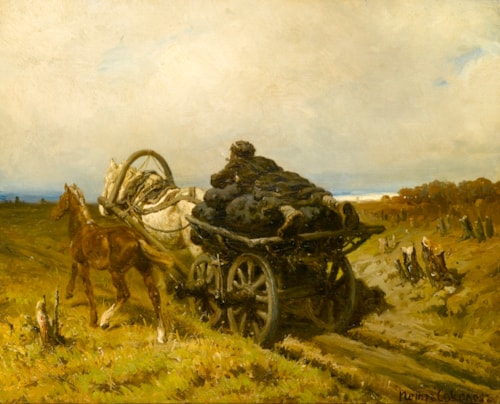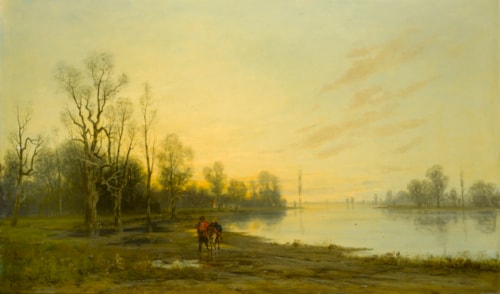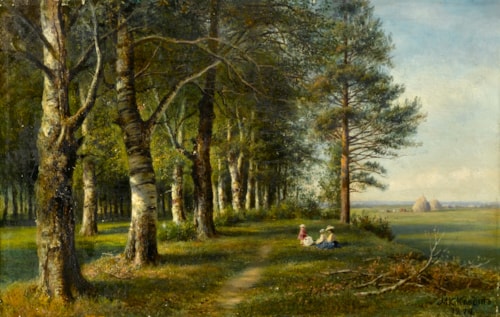driaen de Gryeff
(Antwerp c. 1670 - Brussels 1715)
Diana and her Nymphs Resting after the Chase, with an Abundance of Dead Game
oil on panel
38.7 x 49.5 cm (15¼ x 19½ in)
This vibrantly coloured and detailed work vividly displays the dead game pieces for which de Gryeff was well known. Whilst the work ostensibly concerns Diana, the goddess of the hunt, she seems almost secondary in the face of such exquisite, naturalistic detailing of the dead game laid out around her, the remnants of her chase. Unlike conventional depictions of the goddess where she is often dressed in a short tunic and hunting boots, bearing her bow and a quiver full of arrows, she is here arrayed in a luxurious blue silk dress with a gold cloak. She is made recognisable as Diana by the small crescent moon upon her brow which identified her with Luna, the moon goddess with whom she was also associated. In her right hand she does appear to be holding her quiver but it is obscured by the folds of her magnificent garments.
Diana is surrounded by her loyal hounds, one of whom looks up at her adoringly while another, exhausted after a long chase, lies curled up asleep. A wide array of dead birds and animals are arranged at the goddess’ feet, included perhaps more to challenge the artist’s ingenuity than for the purposes of any realistic grouping. Pheasant, turtle doves, hare, a mallard and a beautiful peacock are all among her unfortunate quarry.
De Gryeff’s conception of the abundant game piece as a trophy of the hunt was widely adopted in the seventeenth century. The majority of these pieces reflected the interests and spheres of royalty and nobility and it seems reasonable to suppose that this present work was commissioned with such a patron in mind. The sketchy and flowing brushwork in this painting are closely akin to Johannes Fyt’s (1611-1661) rich and bravura brushwork, which bears out the suggestion that de Gryeff’s work was influenced by him.¹
De Gryeff, a Flemish painter of still lifes and hunting scenes, was the son of the Leiden still life painter, Jacques de Claeuw (1641-1676). In 1687 he is recorded as being a master at Ghent and within the following ten years was in Brussels and Amsterdam. His paintings often focused exclusively on dead game scenes or huntsmen with dogs, with the background becoming merely a vehicle for these highly specialised still lifes, for example, see Dead Game and a Dog. De Gryeff’s paintings are usually fairly small in size, like the present work and are highly detailed in their execution.
¹ Bernt, W., The Netherlandish Painters of the Seventeenth Century (Phaidon Publishers Inc., New York, 1969), vol. I, p. 47.
Geheimrat Johannes Stumpf, Berlin;
his sale, Berlin, Lepke, 7 May 1918, lot 43;
Kommerzienrat Otto Held, Berlin;
his sale, Berlin, Cassirer & Helbing, 5 December 1929, lot 18, for DM 2850;
anonymous sale, Brussels, Palais des Beaux-Arts, 12 March 1951, lot 53 (all of the above as by Jan Fyt);
where purchased by the family of the previous Belgian collector.
Berlin, Paul Cassirer, Ausstellung von Werken alter Kunst aus Berliner Privatbesitz, May-June 1915, cat. no. 46.
This vibrantly coloured and detailed work vividly displays the dead game pieces for which de Gryeff was well known. Whilst the work ostensibly concerns Diana, the goddess of the hunt, she seems almost secondary in the face of such exquisite, naturalistic detailing of the dead game laid out around her, the remnants of her chase. Unlike conventional depictions of the goddess where she is often dressed in a short tunic and hunting boots, bearing her bow and a quiver full of arrows, she is here arrayed in a luxurious blue silk dress with a gold cloak. She is made recognisable as Diana by the small crescent moon upon her brow which identified her with Luna, the moon goddess with whom she was also associated. In her right hand she does appear to be holding her quiver but it is obscured by the folds of her magnificent garments.
Diana is surrounded by her loyal hounds, one of whom looks up at her adoringly while another, exhausted after a long chase, lies curled up asleep. A wide array of dead birds and animals are arranged at the goddess’ feet, included perhaps more to challenge the artist’s ingenuity than for the purposes of any realistic grouping. Pheasant, turtle doves, hare, a mallard and a beautiful peacock are all among her unfortunate quarry.
De Gryeff’s conception of the abundant game piece as a trophy of the hunt was widely adopted in the seventeenth century. The majority of these pieces reflected the interests and spheres of royalty and nobility and it seems reasonable to suppose that this present work was commissioned with such a patron in mind. The sketchy and flowing brushwork in this painting are closely akin to Johannes Fyt’s (1611-1661) rich and bravura brushwork, which bears out the suggestion that de Gryeff’s work was influenced by him.¹
De Gryeff, a Flemish painter of still lifes and hunting scenes, was the son of the Leiden still life painter, Jacques de Claeuw (1641-1676). In 1687 he is recorded as being a master at Ghent and within the following ten years was in Brussels and Amsterdam. His paintings often focused exclusively on dead game scenes or huntsmen with dogs, with the background becoming merely a vehicle for these highly specialised still lifes, for example, see Dead Game and a Dog. De Gryeff’s paintings are usually fairly small in size, like the present work and are highly detailed in their execution.
¹ Bernt, W., The Netherlandish Painters of the Seventeenth Century (Phaidon Publishers Inc., New York, 1969), vol. I, p. 47.
Geheimrat Johannes Stumpf, Berlin;
his sale, Berlin, Lepke, 7 May 1918, lot 43;
Kommerzienrat Otto Held, Berlin;
his sale, Berlin, Cassirer & Helbing, 5 December 1929, lot 18, for DM 2850;
anonymous sale, Brussels, Palais des Beaux-Arts, 12 March 1951, lot 53 (all of the above as by Jan Fyt);
where purchased by the family of the previous Belgian collector.
Berlin, Paul Cassirer, Ausstellung von Werken alter Kunst aus Berliner Privatbesitz, May-June 1915, cat. no. 46.





 contact
contact contact
contact +44 20 7313 8040
+44 20 7313 8040









